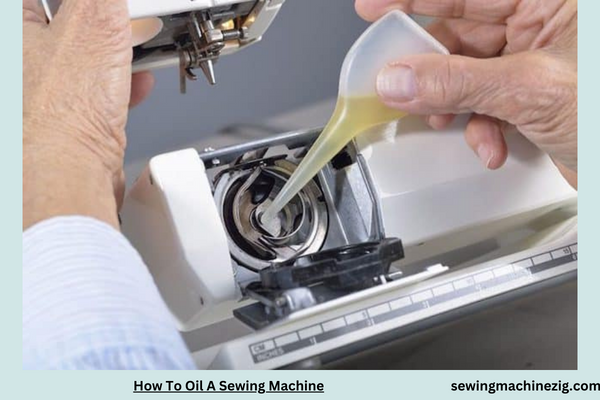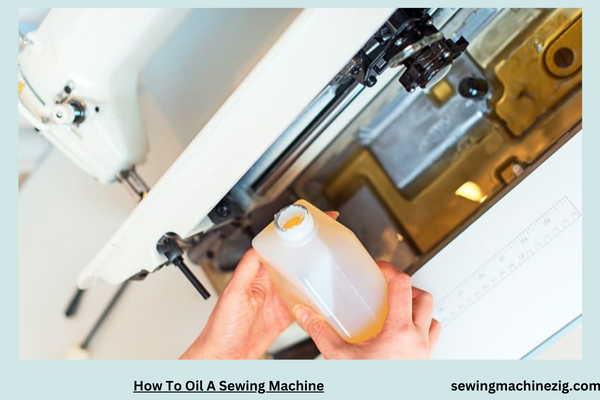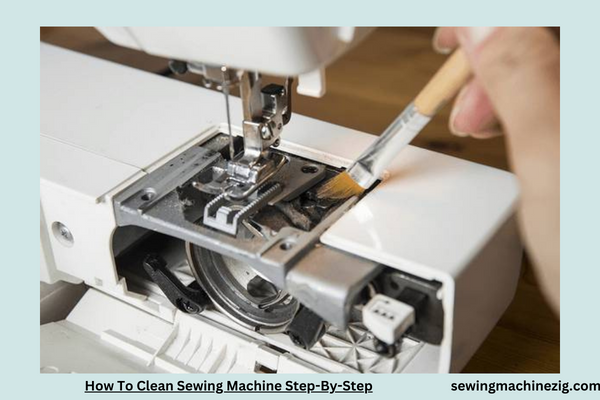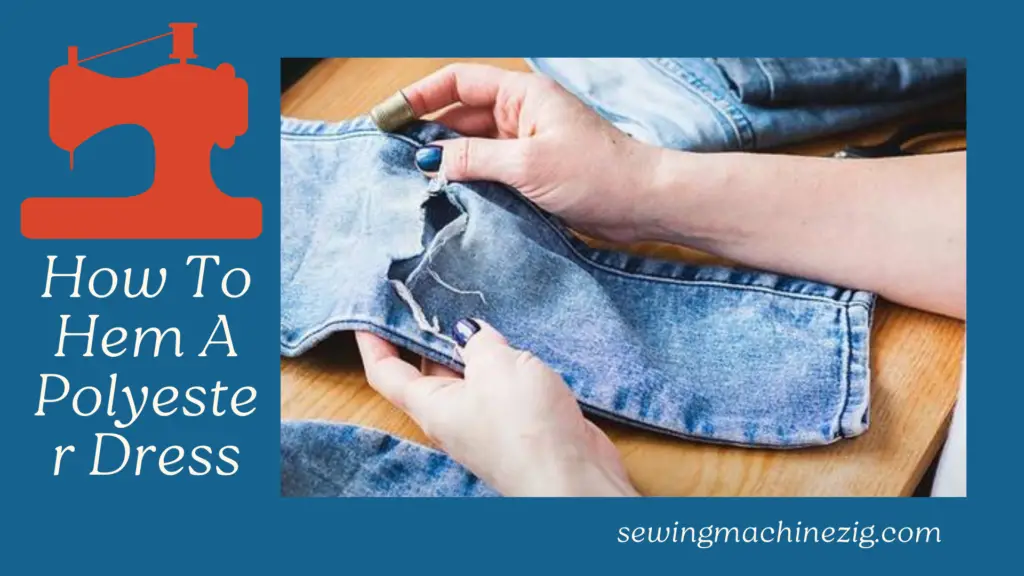
Embarking on the meticulous journey of sewing machine maintenance unveils the crucial ritual of oiling. As the mechanical maestro orchestrates stitches, the necessity of lubrication becomes paramount. Guiding you through this intricate chore, our exploration answers the question: “How To Oil A Sewing Machine?” Navigate the delicate balance between viscosity and precision, ensuring the seamless dance of gears.
Unleash the transformative power of a well-oiled apparatus, where each droplet becomes a guardian of smooth operation. Join us in this tactile odyssey, discovering the art of nurturing your sewing companion through the rhythmic application of oil.
How To Oil A Sewing Machine Detailed Answer

Maintaining your sewing machine is crucial for ensuring smooth and efficient performance, and one essential aspect of this upkeep is oiling. Properly oiling your sewing machine protects its moving parts, reduces friction, and extends its lifespan.
In this comprehensive guide,“How To Oil A Sewing Machine” we’ll walk you through the step-by-step process of oiling a sewing machine, covering the tools you need, common issues, and troubleshooting techniques to keep your machine running seamlessly.
Step 1: Gather Your Supplies
Before diving into the oiling process, gather the necessary supplies:
- Sewing machine oil (recommended by the machine’s manufacturer).
- A small, lint-free cloth.
- A small brush (an old makeup brush works well).
- Your sewing machine’s manual for specific instructions.
Step 2: Prepare Your Sewing Machine
Ensure your sewing machine is turned off and unplugged. Raise the needle to its highest position and remove the presser foot and needle. Open the bobbin case and remove the bobbin. Refer to your machine’s manual for any specific instructions on preparing your machine for oiling.
Step 3: Identify Oiling Points
Consult your sewing machine’s manual to identify the specific points that require oiling. Typically, these points include the shuttle race, the needle bar, and any other moving parts indicated by the manufacturer.
Step 4: Clean the Machine
Before applying oil, use the small brush to remove any dust, lint, or debris from the identified oiling points. Cleaning the machine ensures that the oil will penetrate effectively and doesn’t mix with dirt.
Step 5: Apply Sewing Machine Oil
Dip the lint-free cloth into the sewing machine oil, ensuring it’s not overly saturated. Apply a small amount of oil to each identified oiling point. Be cautious not to over-oil; a little goes a long way. Move any accessible parts back and forth to help distribute the oil evenly.
Step 6: Wipe Excess Oil
After applying oil, use the lint-free cloth to wipe away any excess oil. This step prevents oil from transferring onto your fabric during sewing.
Step 7: Oil Other Accessible Parts
While your machine is open, check for any other accessible parts that may benefit from oiling, such as hinges or joints. Apply a small amount of oil to these areas and wipe away excess oil.
Common Issues and Solutions:
- Squeaky Sounds:
- Issue: Your sewing machine produces squeaky sounds during operation.
- Solution: Oiling the moving parts, especially the shuttle race and needle bar, can eliminate squeaky sounds. Ensure you’re using the right type of oil recommended by your machine’s manufacturer.
- Stitch Irregularities:
- Issue: Your sewing machine produces irregular stitches or skips stitches.
- Solution: Inconsistent stitching can be caused by friction in the moving parts. Oiling the machine helps reduce friction, ensuring smooth and even stitches.
- Difficulty in Handwheel Movement:
- Issue: The handwheel is challenging to turn or feels stiff.
- Solution: Apply oil to the handwheel’s moving parts, allowing for smoother rotation. If stiffness persists, it may indicate a more significant issue that requires professional attention.
- Rust Formation:
- Issue: Rust spots appear on the machine’s metal parts.
- Solution: Regular oiling helps prevent rust formation. If rust is present, gently remove it with a fine abrasive pad or steel wool, then oil the affected area to prevent further corrosion.
Additional Tips for Sewing Machine Maintenance:
- Frequency of Oiling:
- Follow your machine’s manual for recommendations on how often to oil your sewing machine. Some machines require oiling after a certain number of hours of use or every few months.
- Use High-Quality Oil:
- Invest in a high-quality sewing machine oil recommended by the manufacturer. Using the right type of oil ensures optimal performance and protects your machine from damage.
- Avoid Over-Oiling:
- Applying excessive oil can lead to drips and stains on your fabric. Use a minimal amount of oil at each oiling point, and wipe away any excess.
- Professional Servicing:
- While regular oiling is essential, consider professional servicing for a more in-depth cleaning and maintenance. This is especially crucial if you encounter persistent issues with your sewing machine.
By following this step-by-step guide “How To Oil A Sewing Machine” and addressing common issues, you’ll become adept at oiling your sewing machine and maintaining its peak performance. Regular oiling not only prevents potential problems but also ensures a smooth and enjoyable sewing experience. Happy sewing!
How To Clean Sewing Machine Step-By-Step

A well-maintained sewing machine is the key to successful and enjoyable sewing projects. Regular cleaning not only ensures optimal performance but also prolongs the life of your machine.
In this in-depth guide, we’ll take you through the step-by-step process of cleaning your sewing machine, covering essential tools, common cleaning issues, and troubleshooting techniques to keep your machine running smoothly.
Step 1: Gather Your Cleaning Supplies
Before embarking on the cleaning process, gather the necessary supplies:
- Small brush (an old toothbrush or a specialized sewing machine brush).
- Lint-free cloth or cotton swabs.
- Sewing machine oil.
- Screwdriver (if required for removing specific parts).
- Tweezers.
Step 2: Turn Off and Unplug the Sewing Machine
Ensure your sewing machine is turned off and unplugged from the power source. This step is crucial for your safety and prevents any accidental engagement of the machine while cleaning.
Step 3: Remove the Needle and Presser Foot
Remove the needle and presser foot from your sewing machine. This allows better access to the areas that need cleaning and prevents accidental injuries during the cleaning process.
Step 4: Remove the Bobbin and Bobbin Case
Take out the bobbin and remove the bobbin case from the machine. Inspect the bobbin case for any lint or thread remnants. Set these components aside for separate cleaning.
Step 5: Brush Away Loose Debris
Use the small brush or an old toothbrush to gently brush away any loose debris, lint, or dust from the exterior of the machine, including the needle plate, feed dogs, and surrounding areas. Pay close attention to the areas around the bobbin case.
Step 6: Clean the Needle Plate and Feed Dogs
If your sewing machine has a removable needle plate, unscrew it using the screwdriver. Carefully clean the needle plate and feed dogs, removing any trapped threads or lint. If the feed dogs are difficult to access, refer to your machine’s manual for guidance on their maintenance.
Step 7: Remove the Bobbin Case and Clean Its Housing
Remove the bobbin case housing if possible, and clean it thoroughly. Use the brush and tweezers to dislodge any debris or lint that may have accumulated in and around the housing. Take extra care not to damage any delicate components.
Step 8: Clean the Tension Discs
Gently floss between the tension discs using a folded piece of lint-free cloth or a specialized cleaning tool. This helps ensure smooth thread tension during sewing.
Step 9: Oil the Machine
Apply a small amount of sewing machine oil to the designated oiling points. Refer to your machine’s manual for specific locations that require lubrication. Oiling reduces friction, prevents rust, and enhances the overall performance of your machine.
Common Cleaning Issues and Solutions:
- Thread Jamming or Breaking:
- Issue: Thread frequently jams or breaks during sewing.
- Solution: Clean the bobbin area, needle plate, and feed dogs to remove any trapped threads. Ensure proper threading and tension adjustments.
- Uneven Stitching:
- Issue: Stitches appear uneven or irregular.
- Solution: Clean the tension discs and ensure they are free of debris. Check for any obstructions in the bobbin case and remove lint or thread remnants.
- Machine Running Noisily:
- Issue: The sewing machine produces loud or unusual noises during operation.
- Solution: Check for trapped debris in the bobbin area, needle plate, or feed dogs. Apply oil to designated points to reduce friction.
- Difficulty in Bobbin Winding:
- Issue: Difficulty in winding the bobbin smoothly.
- Solution: Clean the bobbin winding mechanism, ensuring it is free from lint and debris. Apply a small amount of oil to lubricate the moving parts.
Additional Tips for Sewing Machine Maintenance:
- Regular Cleaning Schedule:
- Establish a regular cleaning schedule based on your usage. If you sew frequently, consider cleaning your machine every 8-10 hours of use.
- Use Compressed Air:
- For hard-to-reach areas, you can use compressed air to blow away dust and lint. Ensure the air pressure is moderate to avoid damaging delicate components.
- Professional Servicing:
- While regular cleaning is essential, professional servicing is recommended periodically. A professional technician can perform a more in-depth cleaning, lubricate internal parts, and address any potential issues.
- Storage Practices:
- When storing your sewing machine, cover it to protect it from dust. Additionally, remove the needle and cover the needle plate to prevent dust accumulation.
By following this comprehensive step-by-step guide “How To Oil A Sewing Machine” and addressing common cleaning issues, you’ll become proficient in maintaining a clean and efficient sewing machine. Regular cleaning not only enhances performance but also contributes to the longevity of your beloved sewing companion. Happy sewing!
Conclusion
In conclusion, mastering How To Oil A Sewing Machine is an essential skill to uphold the smooth functioning and longevity of your trusted companion. Regular oiling ensures optimal performance, reduces friction, and preserves the intricate mechanisms within the machine. This simple yet vital maintenance task guarantees precision in every stitch and a seamless sewing experience.
By incorporating proper oiling practices into your routine, you safeguard your sewing machine’s efficiency, allowing it to continue weaving creativity seamlessly through each project.
FAQS
Q1: Why is it important to oil a sewing machine?
A1: Oiling a sewing machine is crucial to ensure smooth operation and prevent friction between moving parts. Regular oiling maintains the machine’s longevity and enhances its overall performance.
Q2: How often should I oil my sewing machine?
A2: Frequency depends on usage. For regular users, oiling every 8 to 10 hours of sewing is recommended. Infrequent users should oil the machine before each use, ensuring optimal lubrication. “How To Oil A Sewing Machine“
Q3: Can I use any oil for my sewing machine, or is there a specific type?
A3: It’s essential to use sewing machine oil or a specialized lubricant recommended by the machine’s manufacturer. These oils are designed to provide proper lubrication without causing damage to the machine.
Q4: What areas of the sewing machine should be oiled?
A4: Focus on oiling designated points mentioned in the machine’s manual. Typically, these include the shuttle race, hook, needle bar, and any other points specified by the manufacturer for optimal lubrication. “How To Oil A Sewing Machine“
Q5: Can I over-oil my sewing machine, and is it harmful?
A5: Over-oiling can attract dust and lint, leading to potential issues. Follow the manufacturer’s guidelines regarding the amount of oil and specific locations. A light application is usually sufficient. “How To Oil A Sewing Machine“
Q6: Can I use household oils like WD-40 for my sewing machine?
A6: It’s not advisable. Household oils can cause gumming and attract debris, potentially damaging the machine. Stick to sewing machine oil or lubricants recommended in the user manual. “How To Oil A Sewing Machine“



